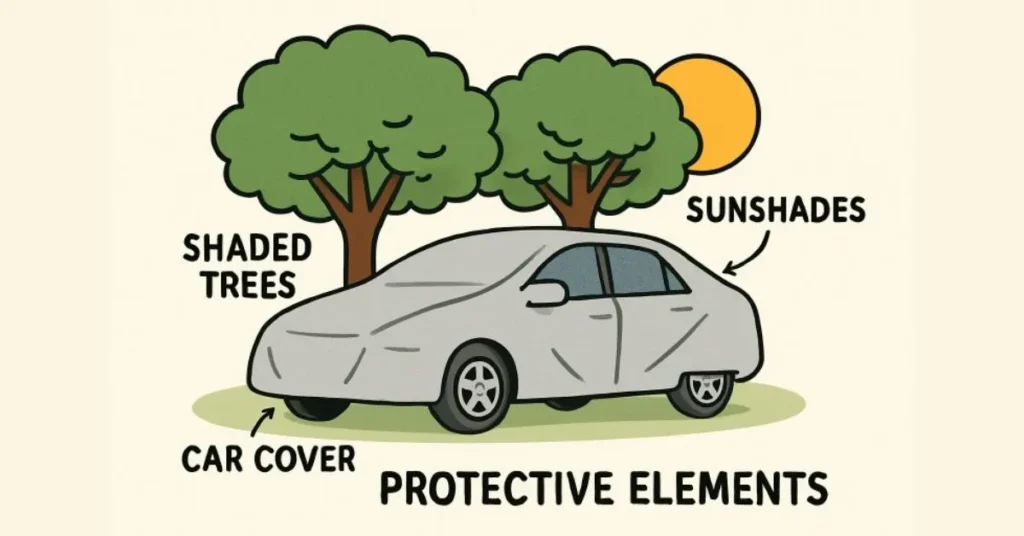Contents
Key Takeaways
- Regular washing and waxing create protective barriers against UV rays.
- Parking in shaded areas and using car covers minimizes sun exposure.
- Interior protectants and window tints safeguard the cabin from heat and UV damage.
- Monitoring tire pressure and fluid levels ensures optimal vehicle performance in hot conditions.
Sun exposure can cause lasting damage to your vehicle, including faded paint, cracked dashboards, and worn upholstery, ultimately reducing its value. Protecting your car from UV rays is crucial for preserving its appearance, comfort, and longevity. Combining professional treatments, such as ceramic coating for cars in New Braunfels, TX, with everyday care provides an effective defense against sun damage. Ceramic coatings create a durable barrier that protects paint from fading and oxidation, while also enhancing shine and durability. If professional options aren’t available, improving maintenance habits can still help safeguard your vehicle. Local experts in New Braunfels offer ceramic coating services that deliver strong protection and lasting results.
Regular Washing and Waxing
Dirt, pollen, and bird droppings do more than just mar your vehicle’s exterior—they can intensify sun damage by trapping heat and accelerating paint oxidation. Regularly washing your car every two weeks helps eliminate these abrasive particles, and applying a quality wax creates a tiny protective layer that blocks harmful UV rays. This layer not only keeps your car looking glossy but also prevents fading and deterioration of the clear coat. For superior and longer-lasting protection, consider exploring professional options, such as automotive ceramic coating near me. Ceramic coatings form a robust shield that repels contaminants and UV damage more effectively than standard wax. By investing in this advanced treatment, you can keep your car’s finish vibrant and easier to maintain over the years.
Parking in the Shade
Whenever possible, choose shade as your first line of defense. Trees, buildings, garages, or even carports offer valuable shelter from direct sunlight, slowing both interior and exterior heat buildup. This can significantly reduce the chances of fading paint, cracked dashboards, and rapidly deteriorating upholstery. If shade is hard to find, try shifting your parking spot throughout the day to take advantage of moving shadows, especially during peak afternoon hours.
Using Car Covers
For vehicle owners without access to covered parking, a UV-resistant car cover is a vital accessory. Modern car covers are designed to be lightweight, breathable, and tailored for a snug fit. This ensures protection from both harsh sunlight and sudden rain, while the breathable fabric prevents trapped moisture, which can lead to mold or mildew under the cover. While it may seem like a hassle, using a car cover regularly is one of the simplest ways to maintain the beauty of your paint, headlights, and trim.
Applying Interior Protectants
The sun’s rays are relentless inside your vehicle, meaning dashboards, leather seats, and door panels can crack, peel, or fade with time. Invest in a UV-protectant spray specifically recommended for your vehicle’s interior surfaces. Regularly applying these products keeps surfaces more supple, preserves original color, and inhibits brittleness. For cars with leather interiors, consider conditioning treatments to further protect against drying and cracking. These steps, combined, extend the appeal and lifespan of the interior features you interact with every day.
Installing Window Tints
Window film technology has advanced considerably, offering excellent heat reduction and UV-blocking benefits without compromising visibility. Quality window tints can block up to 99% of UV rays, keeping cabins cooler and limiting sun damage to all interior components. Properly installed window tint not only protects against fading and cracking but also enhances comfort for drivers and passengers. For a comprehensive overview and expert tips on choosing the right tint, check out this ultimate guide from Gauge Magazine. Remember to check local regulations regarding legal tint percentages—compliance is as important as protection.
Monitoring Tire Pressure and Fluid Levels
High temperatures directly affect your vehicle’s mechanical durability. Overheated tires can lose pressure quickly, leading to blowouts or reduced grip. In extreme heat, fluids—such as coolant, engine oil, and brake fluid—can evaporate or thin out, leading to increased wear on moving parts. Make it a habit to check tire pressures and fluid levels monthly during the summer. Many new vehicles come equipped with sensors and alerts, but for added peace of mind, manual checks can help prevent minor issues from escalating into expensive repairs.
By integrating these practical steps and utilizing professional solutions, you can provide your vehicle with optimal protection against sun-induced aging, costly repairs, and loss of value. With a bit of attention and proactive care, your car remains a vital, good-looking part of your daily life for years to come.

